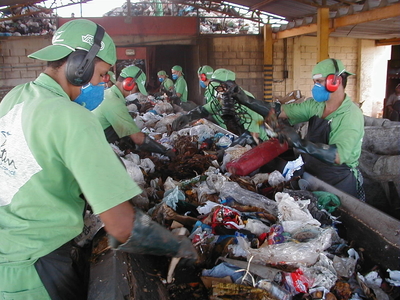The Business Case for Outreach – and Faith in Human Beings
POSTED ON December 4th, 2012 BY admin Are public agencies charged with waste diversion giving up on people too easily?
Are public agencies charged with waste diversion giving up on people too easily?
As an environmental outreach firm working in the solid waste realm, mostly for public agencies, Gigantic Idea Studio has a unique vantage point. We
have long observed a marked underinvestment in outreach by the majority of public agencies. Now these same agencies appear to be giving up on the public when it comes to full compliance and participation in curbside recycling and other resource recovery programs. “It just isn’t working,” or “This is just a community that is never going to cooperate,” are phrases we hear commonly these days. The presumed answer? Technology … such as dirty MRFs, for example.
Will Dirty MRFs Help Us Get to Zero Waste?
What’s a dirty MRF, you ask? Well, a MRF is a Materials Recovery Facility—traditionally an operation in which a combination of people and machines handle the sorting and other processing not taken care of prior to the recyclable materials being placed in curbside carts (or recycling dumpsters, in the case of businesses). At a dirty MRF, unsorted trash—containing all kinds of recyclable material is separated, mostly mechanically, at great expense. And now there are “wet MRFs,” that use water to separate and clean recyclables, and dissolve organic material. These systems require no sorting on the part of residents or businesses, who can throw anything and everything into their cart or dumpster. To many working tirelessly to increase diversion and even reach Zero Waste, this appears to be a wish come true. No more reliance on those pesky humans to do what you want them to, and no more mucking around in the messy business of communication. Or so it would seem.
Giving Up On People Too Soon?
But here’s the thing: wouldn’t it be more beneficial in the long run to change the public’s behavior around recycling? It seems to us that outreach hasn’t been given a proper chance, given the tactics, messaging, design and other communications components that have been used by agencies and haulers thus far. True public outreach is conducted strategically, methodically and unrelentingly—not just when a new program rolls out, but before, during and long after. Effective outreach, resulting in maximum participation by the majority of the public, takes an unceasing drum beat of consistent messaging, compelling professional design and tactics that meet people where they are: out in their communities, not just in their garbage bills. All of this takes resources: budgets of $20,000-60,000 a year in a community of 150,000 just isn’t going to cut it, especially when you remember that public agencies are competing with everyone else’s messaging for “mindshare,” including large corporations with multi-million dollar marketing budgets.
Weighing the Price of Investment: Technology Or Outreach
We can hear the cries of protest already: “If we spent $2.00 a person on outreach, we’d hear from our constituents, and it wouldn’t be pretty.” In a climate of economic downturn and diminishing support for government, we understand that spending on things like websites, recycling guides or exhibit booths can make an agency vulnerable to criticism, and we’re sensitive to that. But consider this: The price tag for building and running a typical dirty MRF runs into the many millions of dollars. If we were sitting in the walnut seats of the venerable City Council chambers around the State, we’d be more worried about the potential outcry about that! Beyond the financial bottom line is the ultimate goal of environmental outreach and a healthier planet And we believe that’s worth working and spending for.